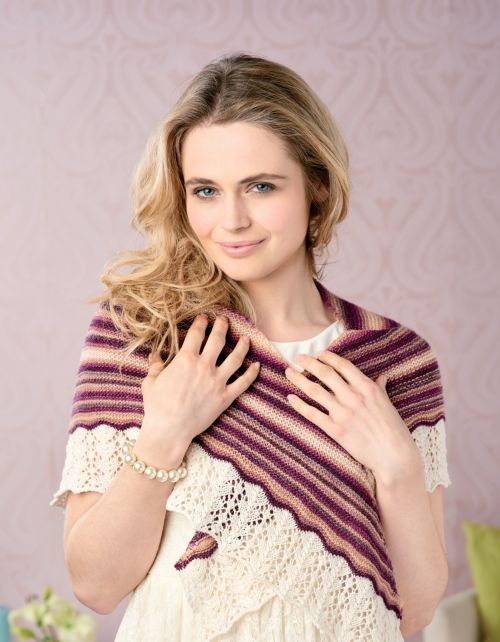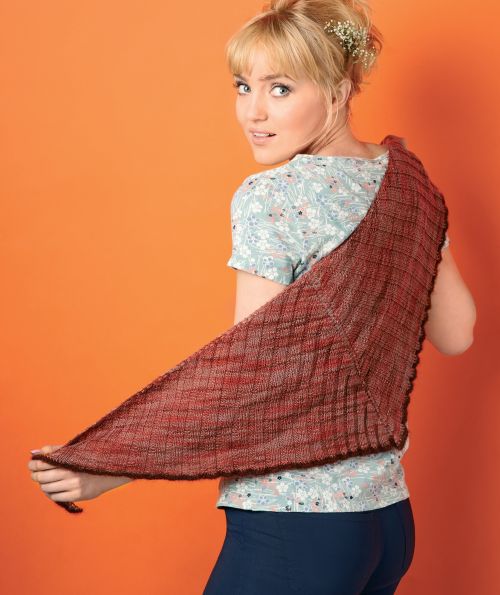These days, that flat piece of knitting that wraps around your shoulders can come in many wonderful forms. Now we can make this accessory as comforting or decadent as we like, it’s no wonder this accessory tops the knitting charts as our favourite knit. With ever-evolving yarns and plenty of pattern sources, shawls have had an exciting image revamp, so take a tour of the shawl evolution in this handy guide.

CHOOSE A GOOD YARN
Whatever the occasion, sunshine or snow, there’s a shawl and a yarn that will go! A smaller wrap is also the perfect excuse to treat yourself to some of those more luxurious or unusual yarns for which you only need a hank or two. For the summer months and indoor ‘do’s, traditional lighter yarns from cobweb or gossamer yarns to lace and sock yarns, and even DK are ideal, and there are plenty of heavenly hand-dyed yarns in breathable fibres to make any design all the more unique. Finer yarns may seem expensive, but check out the meterage and consider the quality of the fibres. What’s more, a little goes a long way with, with 50g of a laceweight yarn having over 350m, which may be more than double a DK ball of the same weight. Lacy patterns also mean that you are not necessarily on a very small needle gauge, so don’t be put off! For an easy knit, choose a ‘shawl in a ball’ yarn as many include colour effects, so you sit back and knit. These larger cakes and wheels also come in heavier weights and warmer fibres, often with synthetic yarn. As yarn goes, we also love a stash-busting shawl, where you can get as adventurous as you like!

THE CONTRASTING THREAD TRICK
Even the most experienced knitter can make a mistake, and on a big or complicated knit, having to undo a big section of work to correct a mistake is something to be avoided at all costs! It’s easy to save this heartache by inserting a line of contrasting thread through all the stitches on the needle after a correct pattern section. Use a tapestry needle and make sure you don’t miss any stitches or split them with the lifeline. Best case: move it up in a few rows; worst case: you only have to rip back a few centimetres – phew!

INVEST IN THE RIGHT KIT
Depending on the cast on and shape, shawls can be started with over a hundred stitches or as few as three, and you may need more than one needle type. Even if your wrap is knitted in rows, a circular needle may be the more comfortable option for taking the weight when your project reaches a certain size. Stitch markers are often needed for keeping on track with where pattern sections begin or end, and are also a time saver when casting on a large number of stitches. Slip on a marker every 20 or so stitches to tot up in a trice. Blocking can really help define points or set a pattern, and for lacy designs, T-pins have a wide head that a stretched piece is unlikely to escape from.

KNOW YOUR CHARTS
Often finer yarns may be wound asskein or hank, rather than a ball, and it is essential to rewind it before you start as otherwise it will just tangle as you knit. A yarn swift is a contraption used to unwind hanks, but the next best thing is a straight-backed chair. First, untie any bindings, snipping close to the knot if needed, then untwist the hank into its big loop and smooth out to find the outer yarn end. Lift the hank over the back of the chair without twisting it, and start to rewind carefully into a ball. It helps to stand over the chair to avoid pulling the yarn.

UNWIND BEFOREHAND
Often finer yarns may be wound asskein or hank, rather than a ball, and it is essential to rewind it before you start as otherwise it will just tangle as you knit. A yarn swift is a contraption used to unwind hanks, but the next best thing is a straight-backed chair. First, untie any bindings, snipping close to the knot if needed, then untwist the hank into its big loop and smooth out to find the outer yarn end. Lift the hank over the back of the chair without twisting it, and start to rewind carefully into a ball. It helps to stand over the chair to avoid pulling the yarn.



_333_180_c1.png)


_Craftihive_Let_s_Knit_Website_Blog_-_7.9.25_HEADER_IMAGE-01__333_180_64_c1.jpg)

_333_180_64_c1.jpg)
 Baby
Baby
 Toys
Toys
 Garments
Garments
 Crochet
Crochet
 Homewares
Homewares
 Dolls
Dolls



Share